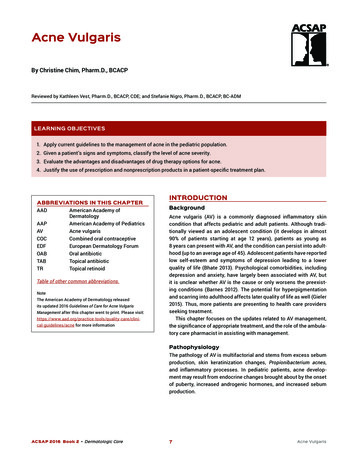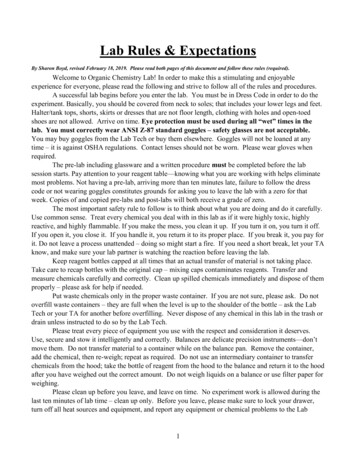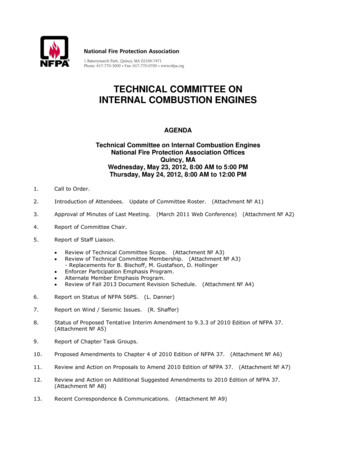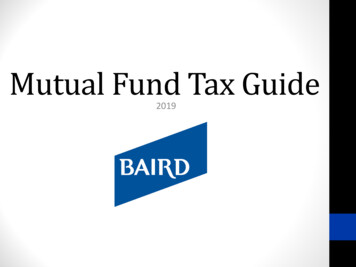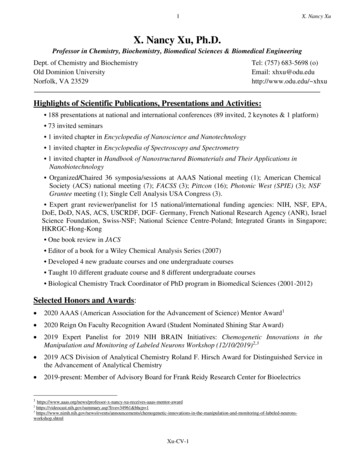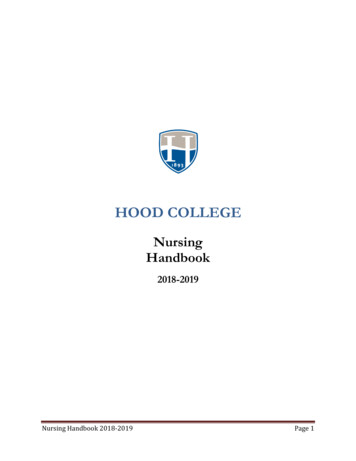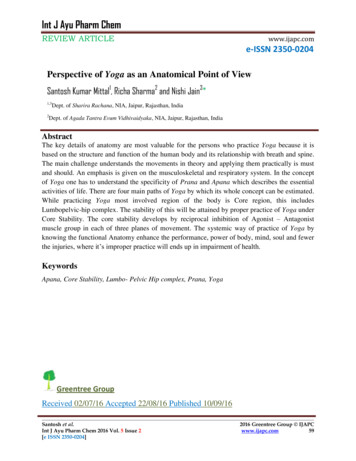
Transcription
Int J Ayu Pharm ChemREVIEW ARTICLEwww.ijapc.come-ISSN 2350-0204Perspective of Yoga as an Anatomical Point of ViewSantosh Kumar Mittal1, Richa Sharma2 and Nishi Jain3*1,3Dept. of Sharira Rachana, NIA, Jaipur, Rajasthan, India2Dept. of Agada Tantra Evum Vidhivaidyaka, NIA, Jaipur, Rajasthan, IndiaAbstractThe key details of anatomy are most valuable for the persons who practice Yoga because it isbased on the structure and function of the human body and its relationship with breath and spine.The main challenge understands the movements in theory and applying them practically is mustand should. An emphasis is given on the musculoskeletal and respiratory system. In the conceptof Yoga one has to understand the specificity of Prana and Apana which describes the essentialactivities of life. There are four main paths of Yoga by which its whole concept can be estimated.While practicing Yoga most involved region of the body is Core region, this includesLumbopelvic-hip complex. The stability of this will be attained by proper practice of Yoga underCore Stability. The core stability develops by reciprocal inhibition of Agonist – Antagonistmuscle group in each of three planes of movement. The systemic way of practice of Yoga byknowing the functional Anatomy enhance the performance, power of body, mind, soul and fewerthe injuries, where it’s improper practice will ends up in impairment of health.KeywordsApana, Core Stability, Lumbo- Pelvic Hip complex, Prana, YogaGreentree GroupReceived 02/07/16 Accepted 22/08/16 Published 10/09/16Santosh et al.2016 Greentree Group IJAPCInt J Ayu Pharm Chem 2016 Vol. 5 Issue 2www.ijapc.com59[e ISSN 2350-0204]
Int J Ayu Pharm ChemINTRODUCTIONmedical science, an emphasis is given on theThe key details of anatomy are mostmusculoskeletal and respiratory systemvaluable for the persons who practice Yoga.because all actions are expressed byThe view of Yoga is based on the structuremusculoskeletal system and breathing is ofand function of the human body. Yogaparamount importance in Yoga.practice emphasizes the relationship of theInterdependence of Yoga on Anatomybreath and the spine. By viewing all theWithout considering the knowledge ofother body structures in light of theirAnatomy, practicing Yoga becomes morerelationship to the breath and spine, Yogadifficult like a blind person visualizes thebecomes the integrating principle for thethings. Without the knowledge of bodystudy of anatomy1. Additionally, for Yogamovements, one should not practice orpractitioners, anatomical awareness is aimplementpowerful tool for keeping our bodies safeapproaching Yoga scientifically is that weand our minds grounded in reality. Thecan often identify elements of practice thatdeepest principles of Yoga are based on aproduce a benefit and then we concur oursubtle and profound appreciation withknowledge of science to amplify the effect3.construction of human system. The subjectBeyond uncovering the misconceptions thatof the study of Yoga is the Self, and the Selfhave spent into our modern understanding ofis dwelling in a physical body2.Yoga, a deeper look reveals the profoundYoga is practice of connecting movement towisdom of our ancient tradition. Once thebreathe.asanatomy of bronchial tree is clearly graspedlocomotion of the body in which majorit becomes clear that it is impossible to fillcontribution is given by musculoskeletalthe lungs from the bottom to top & that thesystem which comprises of muscles, bonestop to bottom method is simply linking theand joints. The main challenge understandsshape and change of breathing to thethe movements in theory and applying themdirection of airflow into the cally is must and should. For thebenefit, a traditional treatment to do Yogaposturesusinganatomicallypreciseterminology, and for correlations withSantosh et al.2016 Greentree Group IJAPCInt J Ayu Pharm Chem 2016 Vol. 5 Issue 2www.ijapc.com60[e ISSN 2350-0204]
Int J Ayu Pharm ChemThis orientation to the breath also links theReview of Ayurvedaflow of respiratory movements and spinalThe approach to the practice of Yoga issupport with the deeper concepts of Pranaholistic a part from5itsscientificallyand Apana .congruent factors. In the concept of YogaWhile practicing Yoga, the pattern ofone has to understand the specificity ofbreathingPrana and Apanaandtheanatomicalandphysiological changes which take place in[7]which describes theessential activities of life.the body are to be known. At the time ofThe word meaning of Prana8 denotes “toinspiration, the external intercostals muscleslive” and “breathe”, but in this contextcontract moving the rib cage up and out, thePrana is not being capitalized, because itdiaphragm moves down at the same time,refers to the functional life processes of acreating negative pressure within the thorax.single entity. The capitalized Prana is aThe lungs are held to the thoracic wall bymore universal term that is used to designatethe pleural membranes and so expandsthe manifestation of all creative life force,outwards as well, which creates negativewhile the word Apana9 is derived from Apapressure within the lungs, so air rushes inwhich means “away”, “off” and “down”.through the upper and lower airways, in theSignificance of these two terms emphasizesmean while expiration is mainly due to thethe purpose of practicing Yoga. There arenatural elasticity of the lungs, which tend tofour main paths10 of Yoga by which itscollapse if they are not held against thewhole concept can be estimated those are as6thoracic wall .follows:Santosh et al.2016 Greentree Group IJAPCInt J Ayu Pharm Chem 2016 Vol. 5 Issue 2www.ijapc.com61[e ISSN 2350-0204]
Int J Ayu Pharm Chem1)Bhakti Yoga– Path of Devotion orthe deep intrinsic muscles13.Love.2)and the specific control of movement fromGnana Yoga – Path of knowledgeThe stability of all these will be attained byand Wisdom.proper practice of Yoga. The whole concept3)Karma Yoga - Path of Action.of this can be made under Core Stability14,4)Raja Yoga- The path of Psychicthe main concept of which is the trunk mustcontrol.be stable if the extremities that are attachedModern Reviewto it are used safely and effectively. It isFunctional anatomy for Yoga is a reliablemust to have balanced relationship with theaspect which has to be focused becausecore muscles. By balance, both strength andrelevant information about musculoskeletalflexibility of the core muscles are equallyanatomy can be located quickly and easily.important. This makes them more adaptable.In most of the cases one can upheld theIn Yoga, this adaptability is used to move ininjuries occurred during practice of Yoga.and out of postures. It is at these momentsWhile practicing Yoga most involved regionthat Yoga practitioners absolutely need theof the body is Core region, this includesstrength and stability of their core so thatLumbopelvic-hip complex11 includes lumbarthey can perform it. When our centre ofvertebrae, pelvis, hip joints, ligaments andgravity is in line with gravity itself, relativemuscles that produce or restrict movementto our body parts, we are in balance and inof these segments. Core muscles includecontrol15.abdominals, iliopsoas, erector spinae, pelvicIffloor muscles, deep gluteal muscles andeffectively, excessive movement of thequadratus lumborum. Core itself impliespelvis and lumbar spine may occur duringdeep and central12. The anatomical structureactivities like Sports, Yoga etc. This happensthat is the deepest and most central is theduring demanding and repeated practice ofspine. Core is directly related to the spineYoga; the lower back will be under strainspecifically, and the torso in general. Thereand ultimately results in pain16. The coreis also a dynamic component to the core.stability develops by reciprocal inhibition ofThis aspect of core is all about movementAgonist – Antagonist muscle group in eachthecoreregionisnotstabilizedof three planes of movement17.Santosh et al.2016 Greentree Group IJAPCInt J Ayu Pharm Chem 2016 Vol. 5 Issue 2www.ijapc.com62[e ISSN 2350-0204]
Int J Ayu Pharm ChemIn the Saggital Plane: Rectus Abdominis,Transverse ndHamstring.In the Transverse Plane: Gluteus Medius,Gluteus Maximus, Piriformis, Superior andInferiorGemelli,QuadratusFemoris,Obturator Externus and Internus, Externaland Internal Oblique, Iliocostalis Lumborumand Multifidus.In the Frontal plane: Gluteus Maximus andMinimus, Quadratus lumborum, AdductorMagnus, Adductor Longus, Adductor Brevisand entifically will converge to improvedperformance and fewer injuries when wehave a fundamental knowledge of theirAnatomy and Biomechanics. Depending onthe type of Yoga prevalence to be given forunderlying structure, overall focus to be onCore region (Lumbo- Pelvic Hip complex).The systemic way of practice of Yogaenhance the power of body, mind and soulwhere it’s improper practice will ends up inimpairment of health.Santosh et al.2016 Greentree Group IJAPCInt J Ayu Pharm Chem 2016 Vol. 5 Issue 2www.ijapc.com63[e ISSN 2350-0204]
Int J Ayu Pharm ChemREFERENCES7. B.K.S. Iyengar, The illustrated light on1. Leslie kaminoff, Yoga and Anatomy,Yoga. Newdelhi: Harper Collins Publishers.yourReprint 2005. Pg techniques,8. Leslie kaminoff, Yoga and Anatomy,United States: Human Kinetics P.O. Boxyour5076 Champaign, ebook 2007 page 1.movements2. Leslie kaminoff, Yoga and Anatomy,United States: Human Kinetics P.O. Boxyour5076 Champaign, ebook 2007 page techniques,9. Leslie kaminoff, Yoga and Anatomy,United States: Human Kinetics P.O. Boxyour5076 Champaign, ebook 2007 page 1.movements3. Swami Satyananda Saraswati, AsanaUnited States: Human Kinetics P.O. BoxPranayama5076 Champaign, ebook 2007 page stures,techniques,publications trust, Munger, Bihar. Reprint10. Swami Satyananda Saraswati, Asana2009.pg 22Pranayama4. H. David Coulter, Anatomy of Hathapublications trust, Munger, Bihar. ReprintYoga: A Manual for students, teachers and2009.Practitioners.11. aBandha.YogaBanarsidass. Reprint 2006, 07. Pg 133-137.content/uploads/2014/05/coremusclesYogaa5. Leslie kaminoff, Yoga and Anatomy,natomy.png)your12. oads/2014/05/coremusclesYogaaUnited States: Human Kinetics P.O. Boxnatomy.png)5076 Champaign, ebook 2007 page 1.13. H. David Coulter, Anatomy of Hatha6. H. David Coulter, Anatomy of HathaYoga: A Manual for students, teachers andYoga: A Manual for students, teachers andPractitioners.Practitioners.Banarsidass. Reprint 2006, 07. Pg 139-142.Newdeldi:MotilalBanarsidass. Reprint 2006, 07. Pg 133-137.Newdeldi:Motilal14. https://en.wikipedia.org/wiki/Core stability 8/1/2016.Santosh et al.2016 Greentree Group IJAPCInt J Ayu Pharm Chem 2016 Vol. 5 Issue 2www.ijapc.com64[e ISSN 2350-0204]
Int J Ayu Pharm Chem15. 05/coremusclesYogaanatomy.png)16. Clare E. Milner, functional Anatomy forsport and exercise, Taylor & Francis eLibrary, 2008. Pg 7.17. Ray Long M D, Anatomy for Yoga Tipsand Techniques book1, A compilation fromthe “Daily Bandha” ebook 2011.pg 20.Santosh et al.2016 Greentree Group IJAPCInt J Ayu Pharm Chem 2016 Vol. 5 Issue 2www.ijapc.com65[e ISSN 2350-0204]
8. Leslie kaminoff, Yoga and Anatomy, your illustrated guide to postures, movements and breathing techniques, United States: Human Kinetics P.O. Box 5076 Champaign, ebook 2007 page 2. 9. Leslie kaminoff, Yoga and Anatomy, your illustrat

